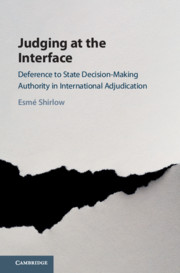Book contents
- Judging at the Interface
- Judging at the Interface
- Copyright page
- Dedication
- Contents
- Figures
- Tables
- Foreword by Judge James Crawford
- Acknowledgements
- Table of Cases
- Table of Treaties, Resolutions, and Declarations
- Abbreviations
- Introduction Deference and the International Adjudication of Private Property Disputes
- Part I Conceptual Framework and Methodological Approach
- 1 Defining Deference: The Connection between Deference and Authority
- 2 Deference in Context: Domestic Authority and International Private Property Claims
- 3 Locating Deference: The Function of Deference in Legal Adjudication
- Part II Deference in the International Adjudication of Private Property Disputes
- Part III The Systemic Role of Deference in International Law
- Appendix Data Tables
- References
- Index
1 - Defining Deference: The Connection between Deference and Authority
from Part I - Conceptual Framework and Methodological Approach
Published online by Cambridge University Press: 24 February 2021
- Judging at the Interface
- Judging at the Interface
- Copyright page
- Dedication
- Contents
- Figures
- Tables
- Foreword by Judge James Crawford
- Acknowledgements
- Table of Cases
- Table of Treaties, Resolutions, and Declarations
- Abbreviations
- Introduction Deference and the International Adjudication of Private Property Disputes
- Part I Conceptual Framework and Methodological Approach
- 1 Defining Deference: The Connection between Deference and Authority
- 2 Deference in Context: Domestic Authority and International Private Property Claims
- 3 Locating Deference: The Function of Deference in Legal Adjudication
- Part II Deference in the International Adjudication of Private Property Disputes
- Part III The Systemic Role of Deference in International Law
- Appendix Data Tables
- References
- Index
Summary
This Chapter introduces the concept of deference and illustrates how it functions in international adjudication. Section A links the concept of ‘deference’ to that of ‘authority’. It explains that ‘authority’ refers to an actor’s ability to induce deference from another actor. Linking deference to authority provides a conceptual framework to expand the analysis of possible reasons for deference, and further explains why different adjudicators may structure deference more or less categorically. The Chapter introduces the concept of ‘second-order reasons’, and examines four accounts of authority based upon differing second-order reasons. It uses this analysis to explore why international adjudicators might defer to domestic decision making authority. Section B examines how theories of authority impact the ‘degrees’ of deference. Some theoretical accounts conceptualise authority as conclusive or suspensive, and thus their application in adjudicative reasoning might prompt categorical approaches to deference. Other approaches to conceptualising authority, by contrast, accommodate more flexible analysis. This conceptual framework informs the empirical evaluation in Part II.
Keywords
- Type
- Chapter
- Information
- Judging at the InterfaceDeference to State Decision-Making Authority in International Adjudication, pp. 15 - 42Publisher: Cambridge University PressPrint publication year: 2021

